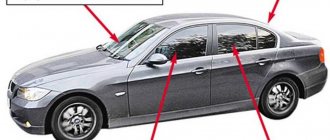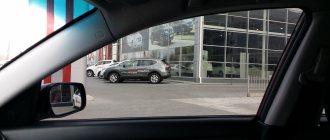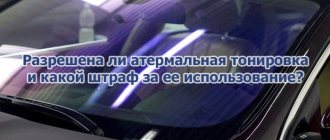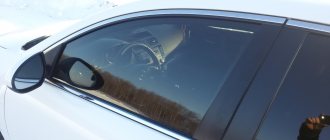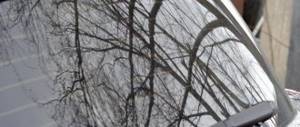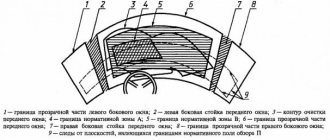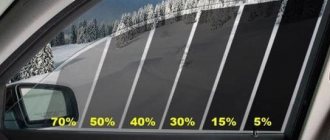Tinting rules in 2021
Acceptable glass tinting according to GOST. The guest says that for the windshield the light transmission value for the windshield is at least 75%, and for the remaining front windows - 70%. The higher the percentage, the more light enters the car interior through the glass.
However, according to the technical regulations of the Customs Union, front windows, including the windshield, must transmit at least 70% of the light. Traffic police officers use data from this regulation, and not from GOST. This means that for all front windows the light transmission value must be at least 70%.
Checking the tint level. To check how much light glass lets in, inspectors use a special device called a taumeter. It consists of two parts - a light source and a receiver. The inspector places the emitter on the outside of the glass, and the receiver on the inside. The more light the receiver receives, the higher the transmission percentage.
The weather during the measurement is not important. Previously, the taumeter had to be calibrated each time to the light level at different times of the day. Modern devices have their own light source, and the level of natural light does not affect the result.
How much light should tinted glass let in?
This is how the inspector measures light transmittance. The device has an emitter on one side and a light receiver on the other. Source: meta-moscow.ru
What window tinting is allowed?
Manufacturers use darkening mixtures even at the time of manufacturing car windows. Substances are added to the material that create a darkening effect, or vacuum deposition is applied, which is a thin metal layer. Factory tinting is one of the most durable, wear-resistant and high-quality.
All cars that are officially produced in Russia go on sale with an approved degree of darkening. Manufacturers take into account the requirements of the law and current regulations.
The disadvantage of the factory configuration is that the car owner cannot change the degree of sun protection. An additional layer will reduce the light transmission rate below that allowed by GOST. It is impossible to carefully remove the film applied during the manufacture of the car.
Mirror
Mirror tinting is a polymer film with a reflective surface. The light transmittance of the material ranges from 5 to 85%. Mirror glass is prohibited in Russia for any vehicle glass.
Mirror tinting has a special coating.
Athermal
The purpose of athermal film is not to impart any tint to the material to which it is applied, but to reduce the amount of heat penetrating into the interior. Standard film retains a maximum of 20% heat. Efficiency of energy-saving tinting:
- high – retains more than 70% of energy (for example, Crystalline 70, Crystalline 40);
- average – 60-70% (SunTek CXP 80, LLumar AIR 80);
- low – 40-60% (“chameleon”, tinting film with a carbon layer).
Athermal tinting reduces the amount of heat entering the interior.
Athermal films are legal if they have a minor effect on how much light enters the vehicle interior.
For example, Crystalline 90 is a completely transparent film that can be installed on the front windshield and side windows.
Traffic police fine for tinting in 2021
Fine for tinting the windshield. If the windshield transmits less than 70% of the light, the driver will receive a fine of 500 rubles.
Fine for tinting front windows. The fine is the same - 500 rubles if the glass transmits less than 70% of the light.
Penalty for tinting headlights and taillights. If the front lights are any color other than white, yellow and orange, the driver will be disqualified for up to a year. This is said in Part 3 of Art. 12.5 Code of Administrative Offences.
The requirements for taillights are similar: they must not be a color other than red, yellow or orange. The reverse lights and the light above the license plate must be white.
Additional questions and answers
Laws change frequently, so drivers continue to be interested in everything related to permitted tinting.
Is window tinting allowed in Russia?
There is no complete ban on tinting car windows in Russia. Only mirror film is prohibited; athermal film can be applied, adhering to GOST standards. Thus, a light transmittance of 75% should be provided for the windshield, and 70% for the side front rows. There are no requirements for the acceptable level of rear window tinting.
There is no ban on glass tinting in Russia.
How to determine the level of tint
The light transmittance of car windows is checked during maintenance. To independently determine the level of tint at any time, you can buy a special device (a taumeter costs about 30 thousand rubles).
There is an easier and cheaper way. To measure the approximate light transmittance, you will need a smartphone with a camera, a white sheet of cardboard and a graphics editor. Step-by-step instruction:
- Place the white cardboard behind the glass so that the top border of the window is in the middle of the sheet. The cardboard must be rotated so that the lighting is uniform.
- Open the photo in a graphics editor, such as Adobe Photoshop.
- Add blur to remove matrix noise and make the photo black and white.
- Measure the color values at two points on either side of the top edge of the glass.
- Make a proportion to obtain light transmittance. The brightness of the cardboard should be set to 100%.
The accuracy of this method cannot be compared with professional measuring instruments, but it will allow you to form a general idea of the level of tint.
Will a driver's license plate be taken away if he violates GOST requirements?
Until November 15, 2014, traffic police officers had the right to remove license plates for violating GOST requirements. There was no longer any need for this, because back in 2013, car owners were allowed to receive duplicate license plates without approval from the traffic police.
Despite the fact that it is no longer possible to lose license plates for tinting, if there are numerous violations and refusal to pay a fine, the driver’s license may be taken away for a period of 3 months. Punishment is also provided in the form of arrest for up to 15 days and a second fine.
When will all restrictions be lifted?
Almost every year, deputies from different parties submit bills for consideration by the State Duma that abolish fines for violating GOST standards, which relate to changes in the light transmittance of automobile windows.
The authors of the initiatives emphasize that tinting does not affect the safety of driving. On the contrary, such a change reduces the load on the climate system, because the film keeps the car interior cooler in the summer and warm in the winter. In a tinted car, the driver and passengers are better protected from harmful ultraviolet radiation and glare from the headlights of oncoming traffic.
How to avoid getting fined for tinting
Do not glue “blind” tint. Because of it, in the dark, the driver will not be able to notice the danger and react in time - people may get hurt. Such tinting does not let in the required 70% of light - there will be a fine.
Remove the film on site. If an inspector stops you and makes a complaint about the tinting, some drivers remove the film on the spot. Others, to make it easier to return the darkening back, use frame curtains - it’s easier to remove and install them.
Sometimes this helps avoid a fine, but more often a fine is issued.
Pay half the fine. In the first 20 days from the date of the decision, the fine can be paid with a 50% discount. In total, instead of 500, the driver will pay 250 rubles.
Mesh frame curtains for front and rear side windows. Installation takes 10 minutes. Source: ozon.ru
Fines and penalties for incorrect tinting
In fact, there is nothing scary in the Code of Administrative Offenses, although drivers are greatly intimidated by fines for improper tinting. In addition, there are rumors that the car may be sent to the impound lot.
In fact, in article 12.5 clause 3.1. The Code of Administrative Offenses of the Russian Federation allows only one punishment for tinting car windows - a fine of 500 rubles. There are no further consequences for driving a car with incorrect tint. Even repeated violations, even 12 times in a row, do not increase the fine.
Important!
Not a single article of the Code of Administrative Offenses provides for any confiscation of a car to an impound lot. Only a fine. If the inspector demands that the film be removed or tries to take the car to the impound lot, this is an abuse of authority.
Understanding what fine you can expect, you can think 12 times, and only then do tinting that does not comply with GOST.
There is an exception for tinting the side windows on the front door. The traffic police inspector may consider that the dull tinting restricts the view. In this case, he may issue a fine for violating safety rules. Although this is not exactly a fine for tinting, it will actually be a violation of the tinting rules.
Theoretically, during a state technical inspection, you may be charged with making unregistered changes to the design of the car. The fact is that glass has certain technical characteristics that are responsible for safety. Tinting violates these parameters. Therefore, although this is not regulated by law, some experts still believe that these are changes.
Here it is enough to contact another service station that carries out maintenance. Well, or point out to those conducting the inspection that this requirement is not in the law. If there is a violation of the level of light transmission directly on the windshield, you will not be given a diagnostic card.
Note!
In Moscow, the penalties are no different; liability for incorrect tinting is still the same 500 rubles.
How to challenge a fine for tinting
If the driver has eliminated the reasons for the stop, but the inspector still issues a report, a video recording of what is happening will help. Record how you remove the film at the traffic police post. Next, proceed step by step.
Write a complaint. The document must be drawn up in the name of the head of the department whose employee issued the resolution. This data can be viewed in a paper resolution or contact the city traffic police department.
Next, indicate the circumstances under which the report was issued to you and explain why you do not agree with the inspector’s decision. In the attachment, please describe copies of the attached documents - MTPL policy, driver's license, STS and civil passport. Don’t forget to attach a video recording of the film dismantling and the inspector’s work - on a flash drive or disk.
File a complaint. This can be done by registered mail or with a personal visit. The appeal period is 10 days from the day the decision was made.
Wait for a response. The complaint will be considered within 10 days. If the complaint is rejected, the driver can sue the inspector's actions. But because of such a sum, they rarely go to court - almost never.
What norms and standards of tinting are in effect in Russia today?
It should be clarified that the ban on tinting and fines for it do not relate to tinting as such, but only to violations of certain norms established by law.
And to understand the permitted standards for tinting car windows, it is important to know the following: the rear window of a car can be tinted in any way and with any standard of light transmission. The same rule applies to the rear side windows of the car. The upper part of the windshield of a vehicle can be tinted with a transparent film (no wider than 14 cm), its light transmission can be of any size. The side windows of the car can also be tinted, taking into account that their light transmission will not be less than 70%. The new GOST has been in force since 2015; before this, the standards of the old GOST required adherence to the light transmission standard, which allowed a light transmittance level of at least 75%.
Before making a decision about gluing a transparent light filter film onto the car glass, it is necessary to understand the characteristics of not only the film itself, but also the car glass itself. This will help you avoid penalties for tinting. The light transmission of car windows is not a static value. The quality of the glass, its manufacturer, and so on play a role. For example, glass without film can have a light transmittance of about 95%. Therefore, when gluing an additional film on such glass with light transmission characteristics equal to, for example, 70%, the final light transmission characteristic will be 65%. This will become a violation and may result in an administrative fine of five thousand rubles.
Legally permissible tinting of car windows is determined by the relevant GOST 32565–2013. This document regulates the degree of tinting of the windshield, side, rear side and rear windows of the car. The provisions of this document do not apply to vehicle lighting fixtures. GOST takes into account everything - from the quality and characteristics of the automobile glass itself to its manufacturer (taking into account all possible factors). It also stipulates the technical characteristics of the film used for tinting.
It is also necessary to take into account who is tinting and where exactly the tinting is carried out. Poor performance of the task by craftsmen can lead to deviations from the established standards for tinting and light transmission, even when the characteristics of the film and car glass used for tinting should theoretically fall within acceptable limits. Therefore, it is advisable to check the light transmission characteristics after gluing the light-protective film and before leaving the highway, where the traffic police inspector may present an unpleasant surprise when stopping.
It is important to understand that tinting the rear window of a car to any degree of light transmission is only possible if this vehicle is equipped with two rear-view mirrors, allowing the driver to clearly see the traffic situation behind his car.
An important nuance: Rosstandart has indicated that the strip of light-protective film glued to the top of the windshield must have a width of no more than 14 cm and at the same time have any light transmittance. There are cases when self-interested traffic police officers try to “deceive” uninformed drivers by measuring the light transmittance in the upper part, sealed with film. As a rule, it does not meet the standards. So, if the width of the strip pasted on the windshield is no more than 14 cm, then such actions are illegal.
Remember
- The front windows of a car must allow at least 70% of light into the cabin.
- The amount of light is measured with a special device - a taumeter. You can measure even at night - the device has its own light source.
- The fine for tinting windows is 500 rubles. The repeated fine is the same.
- To avoid getting fined for tinting, do not cover your car windows with it. Sometimes you can avoid a fine if you remove the film on the spot.
- If you do not agree with the fine, write a complaint to the traffic police. In the main part of the document, describe the essence of what happened and argue for the cancellation of the fine. The answer will be given within 10 days.
All articles by the author: Evgeniy Lesnov
Why do you need window tinting?
Tinting reduces the amount of ultraviolet radiation penetrating into the car's interior, extinguishes the blinding light of oncoming traffic headlights and protects the interior trim from fading. Tinted glass maintains driver privacy while still providing good visibility from inside the vehicle.
The film is attached without glue, so it does not damage the glass. Tinting improves the wear resistance of the material by absorbing micro-scratches. But the idea that darkening improves safety is wrong.
Modern glass is made so as not to shatter into small fragments in an accident. The windshield does not break, but becomes covered with cracks, the side ones scatter into small fragments with rounded edges that cannot injure a person. The film not only does not contain fragments, but can also affect the initial characteristics of the glass, their “behavior” in an accident.

